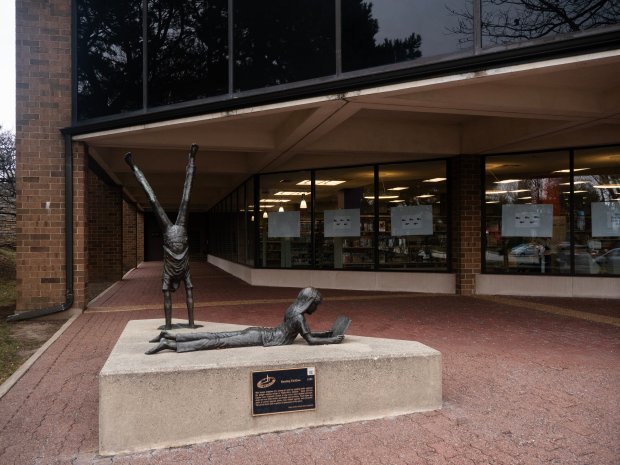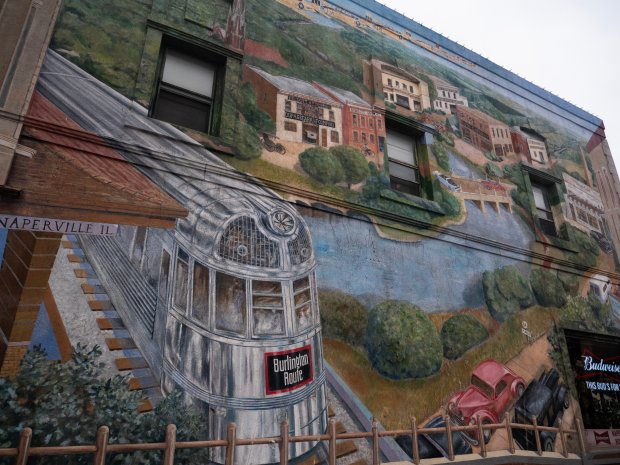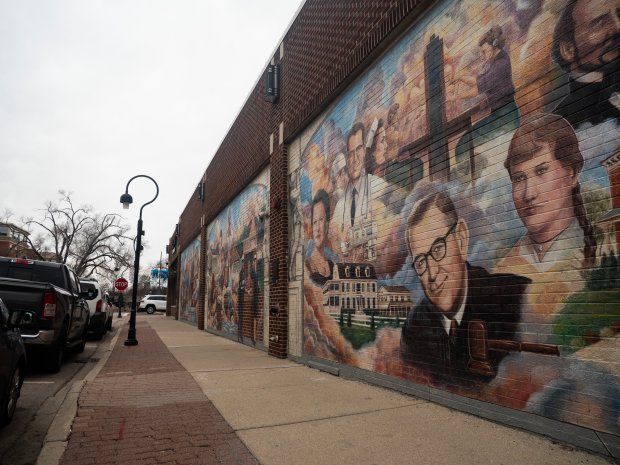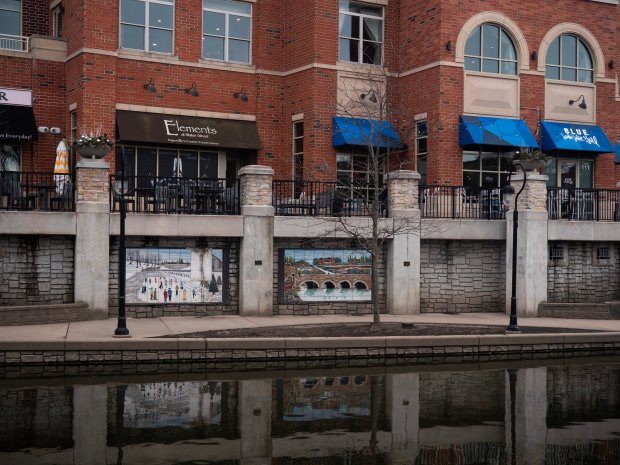A wide-eyed Cat in the Hat, out for an afternoon stroll wearing his trusty top hat. A boy and a girl — descendants of some of Naperville’s earliest founders — sit holding hands and sharing a soft gaze. An old local journalist watches the city pass by with a pen and paper in hand.
Brand Bobosky has helped Naperville tell a lot of stories in bronze, glass and broad strokes over the years. But after more than two decades at the helm of the city’s premier partner for public art around town, he says it’s nearly time to step down.
At the end of this year, Bobosky will retire from his role as president of Century Walk Corp., he said. The decision, he said, is both because he is getting older — his 85th birthday is in November — and there is a need for change after years of tense relations between the nonprofit organization and the city.
“There’s plenty of interest and plenty of things to continue to tell the Naperville story as the community evolves … in a fashion that separates us from so many other communities,” he said. “It doesn’t need me. It’s there, but what it needs is the acknowledgment, the consciousness of what it is (to) enable it to go on.”
Bobosky founded Century Walk in 1996. And for the past 27 years, the nonprofit has been in charge of soliciting and producing murals, sculptures, mosaics, fountains and other art pieces throughout the city.
But since 2020, the role that Century Walk has played in Naperville’s public art scene has been strained as the city developed its own public arts program and questions over the nonprofit’s funding arose.
“Now, at this point, it’s time to start looking at the future,” Bobosky said.
Retiring, though, comes with its fair amount of looking back.
Years in the making
“I’ve got 15 to 20 boxes of records to go over,” Bobosky said. “There’s a lot there. I’ve been very fortunate that my memory is still pretty good. There’s been so many great stories of who did what and how this happened.”
The idea for Century Walk blossomed in the early 1990s, spurred by a similar public art program a few thousand miles away.
Since the 1980s, Chemainus, a town in British Columbia, has brought in muralists and turned itself into a tourist destination after the sawmill company, once the town’s economic foundation, went out of business.
Bobosky read about the project in Smithsonian magazine. It inspired the longtime local attorney, and he began organizing a similar program for Naperville with other city residents.
“I got to thinking that if they could build a Ford, we could build a Cadillac in Naperville,” he said in a 2002 Sun article.
By 1996, his local version officially came to fruition with a nod from the Naperville City Council — but not without a concerted push from Bobosky.
Former Century Walk board member Dee Pasternak, who died in 2004, told the Sun in 2002 that the council “didn’t just hand it out on a platter” and that Bobosky “really had to talk it up.”
She added, “Once Brand has the desire to do something, he’s a fireball. … He’s pretty much a superman.”

From inception to date, Century Walk, under Bobosky’s leadership, has helped pepper Naperville’s streets, landscape and walls with more than 50 art pieces. The installations are valued at more than $4 million, equally funded by public money and private donations.
It’s hard not to see at least one of Century Walk’s contributions when walking the city’s downtown. There’s the Pillars of the Community mural, a colorful art-deco rendering of significant people, places and scenes in Naperville history that stretches the south wall of Sullivan’s Steakhouse.
Down by the river, you’ll see a sculptured snapshot of the two businessmen who were the driving force behind the Naperville Riverwalk. Across the street, by Nichols Library, a pair of kids cast in bronze — barefoot, of course — read and play.

Dale Rogers, a Massachusetts-based artist whose work joined the Century Walk collection in 2014 with a sculpture along the Riverwalk, called the nonprofit’s success “something that people need to appreciate.”
“(Public art) is one of the last improvements we make in our communities,” he said. “So when a community gets to that point, or when you have citizens that are inclined to take that role on, it should be viewed as a very special thing.”
How people go about managing and creating public art in Naperville, though, has raised some questions in recent years.
Overseeing public art
Changes started in February 2020, when elected leaders suggested a public art task force be formed under the auspices of Naperville’s Special Events and Cultural Amenities, or SECA, to develop a strategy for public art and evaluate projects before city money is requested.
Meanwhile, Century Walk officials started imploring the city for more consistent funding than received in previous years. From the beginning, Century Walk has benefitted from city funding as a supplement to private donations.
City support comes through grants that SECA doles out annually to benefit the arts and community events. Most organizations apply for SECA money, while a few receive guaranteed funding called city obligations.
Century Walk had been receiving $50,000 a year as an obligation to maintain public art, but in March 2021 it requested the council earmark an additional $150,000 for new public art annually. A compromise to give the group $100,000 over a three-year period, through 2024, narrowly passed the council later that summer, despite concerns that arose over the nonprofit’s overhead and management fees.
The terms under which money would be released, however, weren’t codified until last year. Parameters included that Century Walk submit a financial audit to the city and that funding be used to develop or maintain art on city property.

Century Walk officially satisfied all stipulations in December, after it submitted a long-awaited audit to the city, according to City Clerk Dawn Portner, who was previously Naperville’s special events coordinator.
In meeting all terms of its funding agreement with the city, Century Walk is in line to be allocated $150,000 of its obligated SECA money this year, Portner said. Grants for SECA’s 2024 program are to be approved Tuesday by the council.
Planning for the future
Bobosky said with the funding, Century Walk will be focused primarily on maintenance this year.
“We have five or six maintenance problems that need to be done. (Those) could spend $100,000 alone,” he said.
A complicating factor is the city’s requirement that SECA money go towards art pieces on city property only, Bobosky said. Of Century Walk’s 53 projects, 22 are on private land.
“People don’t understand that public art isn’t always on public property,” Bobosky said. “The public aspect means that it’s available to the public free of charge, every second of every day. … That (lack of understanding) is a roadblock.”

As Bobosky imagines a future for Century Walk without him, he reiterated that “it doesn’t need me.”
“It needs to have some freedom here so it can continue to operate in the fashion which it had for a number of years, very successfully, without being hamstrung,” he said.
He offered three paths for the nonprofit once he retires: go on as it has but under a successor; have the city take the operation over; or liquidate the corporation.
Bobosky has offered to stay on in an advisory capacity to help facilitate a smooth transition should Century Walk continue.
Naperville City Manager Doug Krieger said the city is working to figure out what a Century Walk without Bobosky means for Naperville and the art it’s helped curate.
“You know, we don’t know what that looks like, and there isn’t a formal plan in place that says, ‘Hey, here’s how the city is going to take care of public art moving forward,’” Krieger said. “But we’re looking at different options.”
Krieger also stressed that “we’re all very grateful for the work” Bobosky and Century Walk have done, and “we want to ensure that we have a plan in place to maintain that art so that people can continue to enjoy it in the future as well.”
The city is looking to SECA’s public arts arm — which was formalized in 2022 — for guidance, he said.
Bobosky is hopeful Century Walk will continue to have a place in Naperville after he leaves.
“There’s plenty more (stories) to tell,” he said. “Just, I won’t tell them.”





